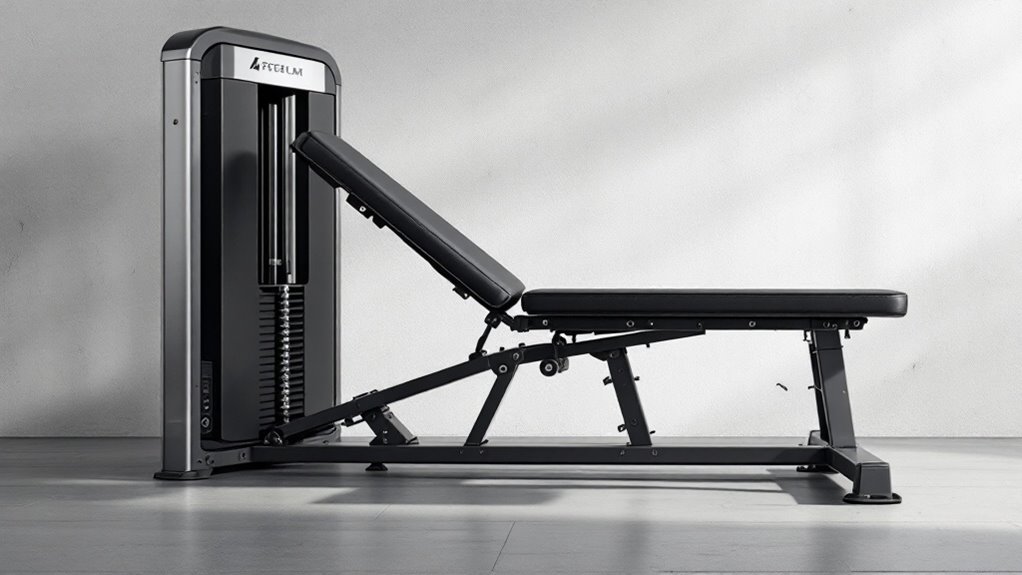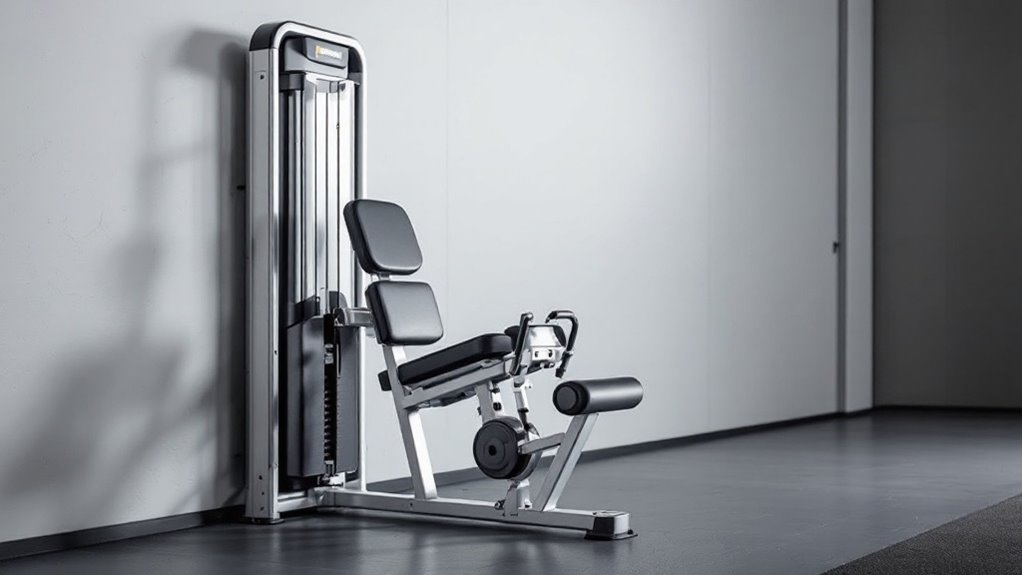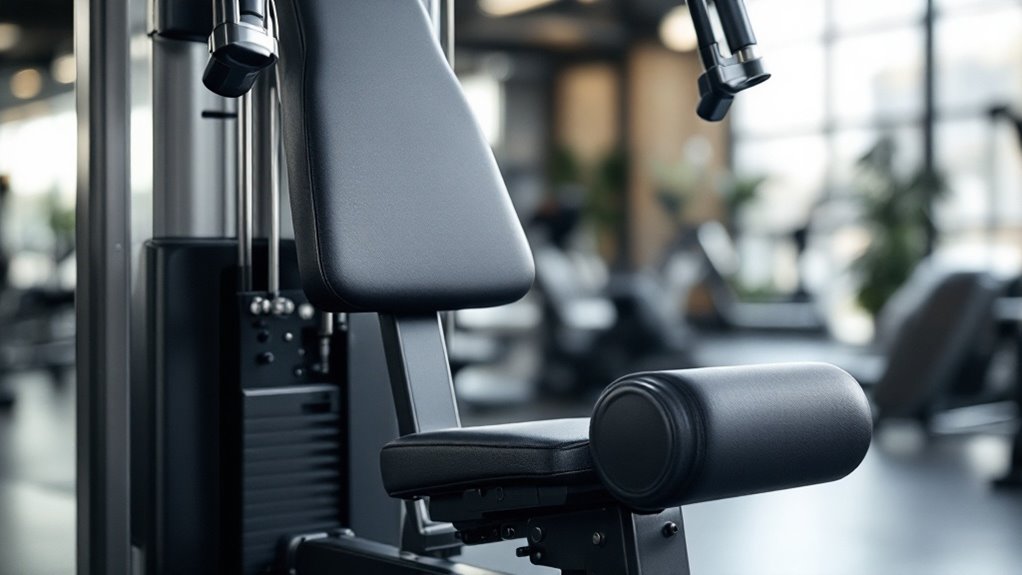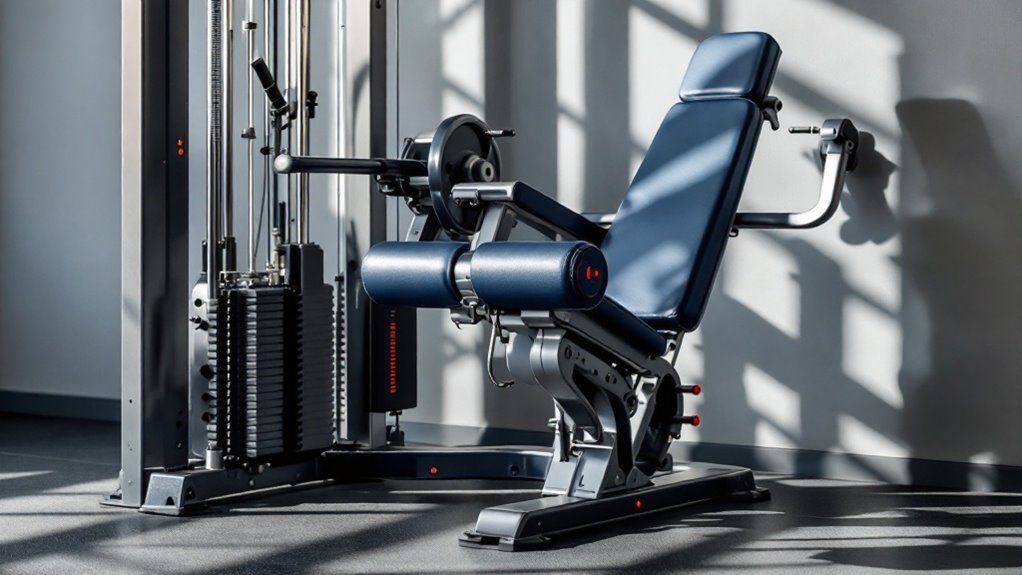Hamstring Machine Exercises

Hamstring machine exercises offer targeted muscle isolation and strength development through specialized equipment designed for maximum safety and effectiveness. Key movements include seated leg curls, lying leg curls, and glute-ham raises, each focusing on proper form and controlled tempo. Success requires maintaining neutral spine position, appropriate weight selection, and systematic progression over time. Mastering these fundamentals reveals the full potential of machine-based hamstring training.
Key Takeaways
- Seated leg curls isolate hamstrings while maintaining spine neutrality, making them ideal for beginners and advanced lifters alike.
- Lying leg curls target hamstring muscles effectively while minimizing stress on the lower back during execution.
- Proper machine setup and form includes maintaining a flat back, controlled movements, and appropriate weight selection.
- Progressive overload through gradual weight increases and consistent form helps prevent plateaus and ensures steady strength gains.
- Regular hamstring machine training reduces injury risk while providing constant muscle tension throughout the complete range of motion.
Benefits of Machine-Based Hamstring Training

Machine-based hamstring training delivers unique advantages that complement traditional free-weight exercises in a modern fitness program.
These machines provide targeted isolation of the hamstring muscles while maintaining constant tension throughout the full range of motion. This focused approach allows for precise control over resistance levels and movement patterns.
Hamstring machines excel at muscle isolation, delivering consistent tension and precise control for optimal training adaptations and strength gains.
The controlled environment of hamstring machines minimizes injury risk by guiding users through proper form. Moreover, these machines enable beginners to build foundational strength safely while allowing advanced lifters to push intensity without compromising technique.
The ability to adjust resistance incrementally makes it easier to track progress and implement progressive overload systematically.
Top Hamstring Machine Exercises for All Fitness Levels

Whether just starting a fitness journey or training as an experienced athlete, incorporating effective hamstring machine exercises can dramatically improve lower body strength and stability.
Machine-based training offers controlled resistance and proper form guidance, making it ideal for developing these vital posterior chain muscles.
Following progressive overload principles helps prevent training plateaus while safely building hamstring strength over time.
- Seated Leg Curl: Targets the hamstrings through a full range of motion while maintaining spine neutrality
- Lying Leg Curl: Isolates hamstring muscles effectively while minimizing lower back stress
- Standing Leg Curl: Boosts functional strength and improves balance during single-leg movements
- Glute-Ham Raise Machine: Builds eccentric strength and posterior chain power
- Cable Pull-Through: Develops hip hinge pattern while strengthening hamstrings and glutes simultaneously
Proper Form and Technique Guide

Mastering proper form on hamstring machines serves as the foundation for safe and effective lower body training.
When using these machines, maintain proper spinal orientation by keeping the back flat against the pad. Start with a moderate weight to perfect the movement pattern.
Execute each repetition with controlled tempo, focusing on the eccentric (lowering) phase. Keep the core activated throughout the exercise, and avoid lifting the hips off the seat.
Position feet firmly on the pad, toes pointed forward or slightly outward.
Breathe steadily – exhale during the contraction, inhale during the release.
Just as with neutral spine position in single-arm rows, maintaining proper alignment helps prevent injury and maximizes results.
Adjust the machine settings to accommodate individual body proportions.
Common Mistakes and Safety Considerations

Training on hamstring machines requires attentiveness to avoid common mistakes that can lead to injury or reduced effectiveness. Proper form and mindful execution are essential for maximizing results while maintaining safety during these exercises.
- Using excessive weight that compromises proper range of motion and form
- Rushing through repetitions instead of maintaining controlled movements
- Failing to adjust the machine settings according to individual body proportions
- Bouncing or jerking movements that put undue stress on joints and tendons
- Neglecting to warm up the hamstrings before engaging in heavy resistance training
These mistakes can be avoided through careful attention to technique and gradual progression in weight and intensity. Following a progressive intensity level approach over 12 weeks allows for safer and more sustainable strength development.
Frequently Asked Questions
How Long Should I Rest Between Hamstring Machine Workouts?
Ideal rest between hamstring machine workouts ranges from 48-72 hours, allowing proper muscle recovery and growth.
Advanced athletes may train hamstrings twice weekly, while beginners should stick to once every 3-4 days.
Adequate rest prevents overtraining and reduces injury risk.
The exact timing depends on workout intensity, overall fitness level, and recovery capacity.
Listen to your body's signals for peak performance.
Can I Use Hamstring Machines if I Have Knee Replacements?
Individuals with knee replacements must consult their surgeon and physical therapist before using hamstring machines.
While some patients can safely use these machines after full recovery, proper form and weight adjustments are essential. Start with light resistance and stop if experiencing pain.
Alternative exercises like bodyweight bridges or resistance band work might be recommended initially until cleared for machine use.
Are Hamstring Machines as Effective for Athletes as Free Weights?
While hamstring machines offer controlled movement and consistent resistance, they fall short of the extensive benefits free weights provide for athletes.
Free weights involve stabilizer muscles, improve coordination, and better replicate real-world movements. The machine's fixed path limits functional strength development and natural movement patterns.
For peak athletic performance, free weights should form the foundation of hamstring training, with machines serving as supplementary tools.
What Should I Do if the Machine Seat Doesn't Fit Me?
When a machine doesn't accommodate one's body properly, several adjustments can help.
First, use towels or foam padding to modify the seat position. If that's insufficient, consider alternative exercises like Romanian deadlifts, Nordic curls, or stability ball curls.
Always prioritize proper form and range of motion over using ill-fitting equipment, as improper positioning can lead to injury and reduced exercise effectiveness.
Should I Adjust Machine Settings Differently for Strength Versus Endurance Training?
Machine settings should be adjusted differently based on training goals.
For strength training, use heavier weights with fewer repetitions (4-8 reps) and longer rest periods (2-3 minutes).
For endurance training, use lighter weights with higher repetitions (12-20 reps) and shorter rest periods (30-60 seconds).
Seat position, range of motion, and form remain consistent regardless of the training focus.
Final Thoughts
Like forging steel, consistent hamstring machine training builds strength and resilience when performed correctly. By following proper form, avoiding common mistakes, and selecting exercises appropriate for their fitness level, individuals can effectively target these essential posterior muscles. Whether using the seated leg curl, lying leg curl, or other machine variations, a well-executed hamstring routine remains fundamental to achieving balanced lower body development and injury prevention.


